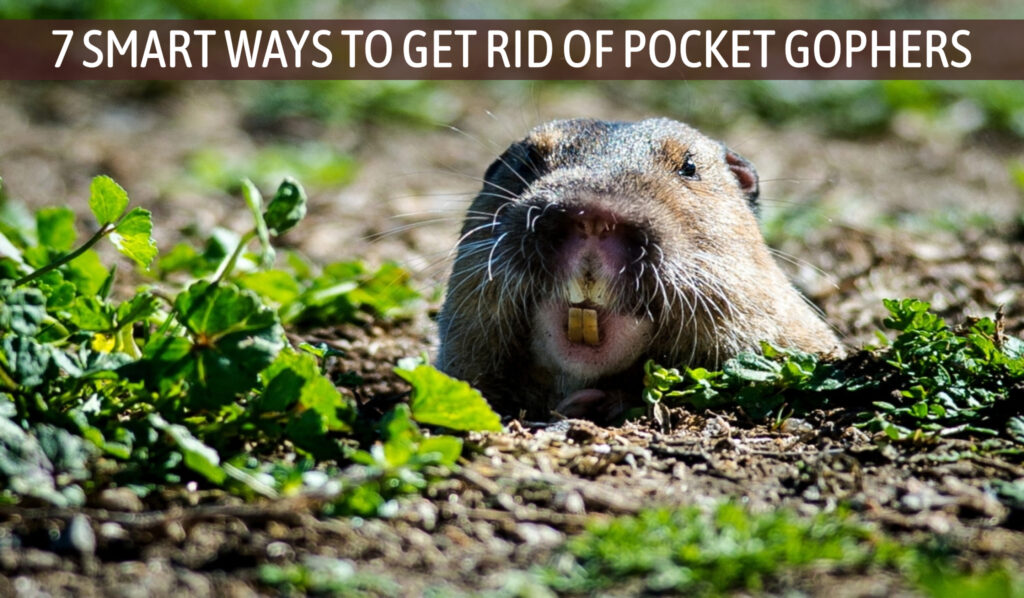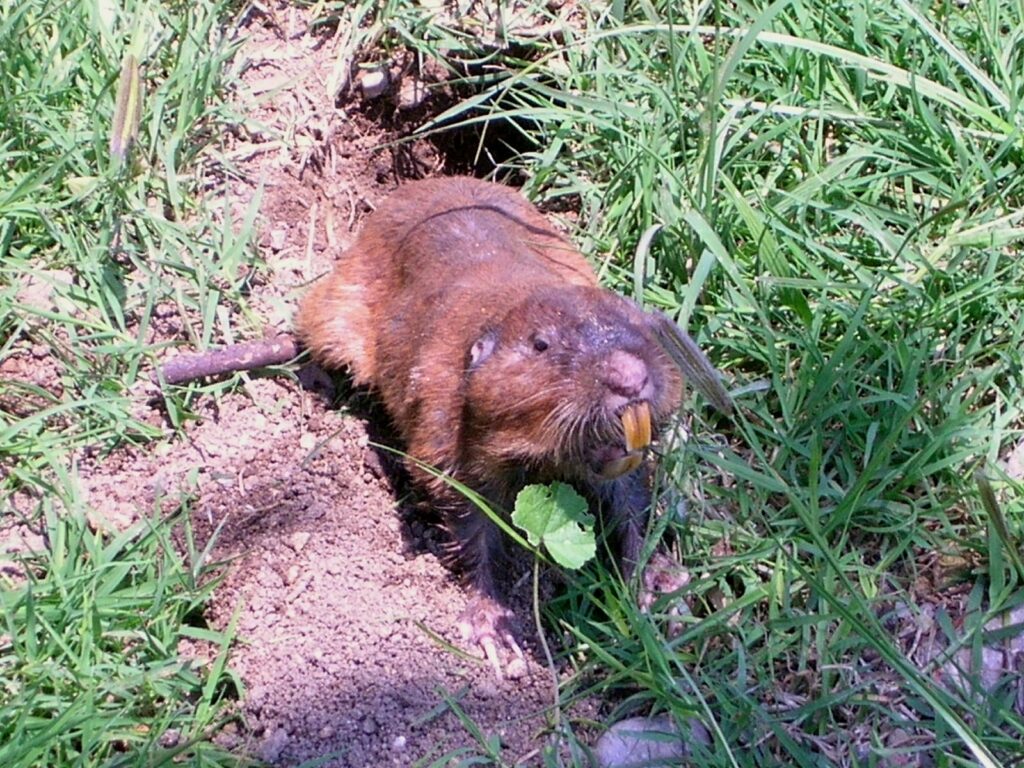
What are pocket gophers?
Pocket gophers, medium-size burrowing rodents with lengths varying between 5 to 14 inches, (13-36 cm) blessed with limbs well adapted for use in burrowing, are mostly found in the Northern part of America.
This animal is blessed with cheek pouches, eyes and ears though small, whiskers, and tail. Their adaptation to burrowing is modified such that they can lock up their long incisors in their lips while using their teeth to remove the soil without having stains on their buccal cavity.
They are found in regions with loose sandy soil and green edible plants. In most cases, these creatures make their tunnels in lawns or crop fields to the disadvantage of both house owners and farmers. When they live in household areas, they feed on flowers used as ornamentals and leave dirty mounds in such compounds.
Despite their destructive nature, pocket gophers are of great importance to life. They help to aerate the soil while their tunnels help to control erosion and their waste products nourish the soil. However, these creatures face severe attacks from predators.
Predators like snakes and Weasels pursue them into their tunnels and feed on them while others like Canines and Badgers excavate them out of their tunnels and feed on them. While foraging, they are at risk of being snatched away by owls and hawks.
How to indentify these rodents?
Pocket gophers are identified with fur-lined pouches on each side of their face. As their name implies, these rodents have pockets that can be turned and subsequently used for transportation of food to their tunnels hence their name – pocket gophers.
They have short necks, a flattened and small head, and paws for burrowing. In addition, they have small ears, eyes, and sensitive whiskers for sensitivity in their dark tunnels. The tail, though incompletely haired, is sensitive in guiding these rodents in backward movements as well as functions in thermoregulation functioning as a radiator.
Their abdomen is usually lighter than the top fur in color. They mate during spring and summer to give rise to their young ones in nests inside their tunnels underground. Their gestation period lasts between 18-19 days after which the mother nurses them for about 3 weeks before they are left to fend for themselves. These rodents live for about 3 years before they die.
Why do pocket gophers attack the garden area?
These rodents are attracted to beautiful environments also just like humans hence gophers’ attention are drawn to your yard because:
- Food sources are numerous in the environment so pocket gophers live anywhere food abound. They are herbivores and feed only on green plants especially the roots and tubers of plants. In some instances, these animals graze on the grasses in lawns and other places.
- The soil is loose, sandy soil and easy to excavate. This loose sandy soil enhances their ability to utilize their teeth and claw for burrowing their tunnels easily.
- Pocket gophers are prey to many predators hence they prefer to stay in secured and protected places. Therefore, they burrow their tunnels along fence lines, under trees, or through bushes.

The adult males are longer than females both having colors varying from black, pale brown and white. There are many species of these rodents but are majorly distinguished by the size of their forefeet, claw, and incisors.
Green plants are their major source of food. They have been adapted to their herbivorous lives of feeding on underground roots and tubers as well as other plants found above the ground. They have dentition adapted to this type of feeding. Their teeth have been adapted for their lifestyle.
For instance, they have long incisors for cutting and chewing, possess flattened molars and premolars for grinding. Their chief source of food is the quaking aspen – a popular tree with small rounded stalked leaves.
They are a necessary evil.
Pocket gophers may seem small and harmless but are responsible for severe damages done in farms and gardens. These damages include but are not limited to the destruction of underground utility cables as well as irrigation pipes. These rodents have been shown to reduce crop yield by half-yearly.
They damage trees by exposing their roots during burrowing. On the other hand, these rodents are of economic importance to the ecosystem. Their underground tunnels prevent erosion and aerate the soil. In addition to these, they increase soil fertility, water infiltration and decrease soil compaction.
How to get rid of pocket gophers?
To get rid of these rodents, the following methods are employed.
1. Habitat modification
This leverages the awareness of the habitat and feeding methods of pocket gophers to reduce or eliminate them.
2. Crop varieties
Here trees with more roots and tolerance to these rodents are planted. An example is alfalfa.
3. Crop rotation
This builds on the knowledge that some plants repel pocket gophers. For example, lavender, marigold, caper spurge, etc.
4. Grain buffer strips
This requires cultivating seed grains that make the environment uninhabitable for pocket gophers. These grains are not edible to these rodents at the same time make them uncomfortable and unable to inhabit. This minimizes their immigration into such crucial places as farms, lawns, etc.
5. Exclusion fencing
Here wires are used to make a fence around flowers, shrubs, or landscape trees.
6. Repellents and Frightening devices
Though repellants and frightening devices are not 100% effective and efficient. Those that have proven to be effective are in small areas. An example as noise-making devices, vibration devices, ultrasonic and electronics for repelling pocket gophers have yet not proven effective according to research.
7. Trapping

This is the most and effective method of controlling gophers but many traps are required. These traps are placed in different locations on mounds. However, trapping requires patience and effort as these traps need to be monitored daily. One disadvantage is that people give up easily thereby leading to failure of the trapping but they work best in the springs.
There are 2 methods of trapping: The lateral and main tunnel. Each comes with its merits and demerits. The efficiency of the tunnel trapping method lies non locating the burrow system.
Other methods of preventing and controlling pests include:
- Flooding pocket gophers with the hose out of their holes or tunnels.
- Fumigating pocket gophers with gas, propane, even though or exhaust. Some employ the use of automobile exhausts. This is not advised because of its side effects and hazards which could cause explosions or pollution.
FAQs about pocket gophers
1. What do gophers look like?
Gophers or pocket gophers are small or medium-sized rodents varying from light to dark brown color. Their belly is usually lighter than the top color. They have small eyes, ears, sensitive whiskers, and a sparingly-haired tail. In addition to this, they have a broad flat head and compact body.
However, they have fur-lined external cheek pouches for the transportation of food during foraging. In addition to this, they have claws adapted to burrowing and digging.
2. Do pocket gophers cause damage?
Gophers do not cause damages but their activities can. They burrow underground tunnels leaving mounds of dirt bought out of the tunnel. These dirt mounds may damage lawnmowers, crops, and farm equipment and pose challenges to athletes.
However, pocket gophers feed on underground roots of grasses and plants. These herbivorous rodents make then damage lawns, trees, and gardens as well as continue tunneling during winter as well as damaging properties.
3. Are gophers dangerous?
Aside from being potential threats to lawns, ornamental plants, and trees, pocket gophers are considered potential carriers of rabies which is a microorganism that can cause deviation from the normal state of health. However, they might also carry ticks, fleas, and other pests?
4. Why are pocket gophers infesting my property?
Pocket gophers are very active in the spring and summer. If healthy grasses grow in your lawns with moist soil, then you might just need to start worrying or thinking of how to deal with gophers.
Summing up
In conclusion, pocket gophers may seem small and harmless but are responsible for severe damages done in farms and gardens. These damages include but are not limited to the destruction of underground utility cables as well as irrigation pipes. These rodents have been shown to reduce crop yield by half-yearly. They damage trees by exposing their roots during burrowing.
On the other hand, these rodents are of economic importance to the ecosystem. Their underground tunnels prevent erosion and aerate the soil. Everyone tries to prevent the impersonation of a destructive animal like the pocket gopher and hence needs to be cautious to ensure it is prevented from habiting around residential areas.
This distinctive rodent derived its name from its morphology is sometimes confused for underground squirrels. Pocket gophers are well equipped for their burrowing lifestyle as well as moving in the dark. This mammal feeds on underground tubers and bulbs as well as stems above.
Occupying the soft sandy soil region of the earth, they make their tunnels under trees, near fences or under grasses to be well secured from predators. Being the most hunted prey, scientists fear it might soon go into extinction even though about 34 species exist.
Their habitat in the tunnels might be a hindrance to controlling their activities on farms. The good news is that these rodents can be controlled by exclusion fencing, use of repellants, traps, natural deterrents, baits, etc. Professional help might be sort in the control of pests.
Looking for gopher control in Calgary?
The health hazards associated with having pests around the home cannot be over-emphasized. However, aside from these health risks, there might be potential damages made to the property. Once you notice pests around your home, it’s ideal to contact a pest control outlet quickly.
The fees paid to exterminate or remove pests in Calgary depend on the kind of pest being removed and whether the frequency of visit is monthly, bi-monthly or quarterly. These pest control outlets are fully approved for operation and work per the regulations of the country, come for monthly inspections as well as have staffs who comply with the workspace safety rules.
It is advisable to hire a professional exterminator as there is a reduced risk of accidental contamination, a more effective and long-term solution, provision of first-hand knowledge, and assurance of professionalism in the job.
Self-remedy to kill pocket gopher might be successful but may end up causing potential contamination. However, children may consume those substances unknowingly leading to accidental poisoning or contamination.
Another reason to support the use of professional exterminators in Calgary is to ensure an effective and long-term solution. Professional exterminators sometimes use one vermin which works for a variety of pests thereby making control of others easy. In addition, this, professional apply the experiences gathered to surmount any challenge.
For more information and hire professional services, please contact us on 4038133666

